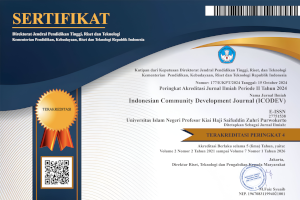Jenang Grendul as A Symbol The Month of Safar in Banjar Patoman, Amadanom, Dampit, The Districts of Malang
DOI:
https://doi.org/10.24090/icodev.v3i1.6350Keywords:
bala’, jenang grendul, Prophet Musa as, SafarAbstract
Jenang grendul is one of the traditional foods in Indonesia. Traditional foods which is part of culture, including foods, drinks or snacks that are traditionally made and consumed, also have developed for a long time, specifically in a certain area in Indonesia. Jenang grendul only made in the month of Safar in Banjar Patoman, Amadanom, Sub-districts of Dampit. The aim of this research is to determine the philosophy of jenang grendul and its relation to the month of Safar. This research is a field research, which is the result is collected by interviewing people around and then supported by some literature. Based on the data obtained, the philosophy of jenang grendul is associated with the story of the Prophet Musa as, especially when King Fir'aun and his troops are drowned. King Fir'aun and his troops were symbolized by grendul and the drowning sea water was symbolized by the jenang sauce. The other information also states that the philosophy of jenang grendul is associated with the warning of thousands of bala' (unlucky days), which sent down by Allah SWT. Both events have occurred in the month of Safar, therefore jenang grendul made in that month as a symbol.References
‘Adawi, Muhammad K. Al-`Ibrah min Qisshah Musa fi Al-Qur`an Al-Karim. Saudi: Jami`ah al- Malik `Abd al-`Aziz, 1980.
‘Afiah, Devy N. “Pengaruh Perbandingan Gula Merah dengan Sukrosa dan Perbandingan Tepung Jagung, Ubi Jalar dengan Kacang Hijau terhadap Karakteristik Jenang”. Skripsi-Universitas Pasundan Bandung, 2017.
Bukhori (al). Mukhtashar Shahih al Bukhori. Beirut: Darul Haq, t.t.
Arganata, Taufan R. “Kajian Makna Simbolik Budaya dalam Kirab Budaya Malam 1 Suro Keraton Kasunanan Surakarta”. Skripsi-Universitas Muhammadiyah Surakarta, 2017.
Asy-Syafrowi, Mahmud. Khidir as Nabi Misterius, Penguasa Samudra yang Berjalan Secepat Kilat. Yogyakarta: Mutiara Media, 2013.
Effendi, Mas’ud. Dkk. “Analisis Kebutuhan Konsumen dalam Pengembangan Jenang dengan Metode Fuzzy Quality Function Deployment (FQFD)”, Jurnal Teknologi & Industri Hasil Pertanian, Vol. 23, No. 1, Maret 2018.
Halim, Amanullah. Musa Versus Fir’aun. Jakarta: Lentera Hati, 2011.
Hidayat, Eky W. “Analisis Usaha Pembuatan Jenang Kudus Pada Industri PJ Muria di Kabupaten Kudus”. Skripsi-Universitas Sebelas Maret, 2010.
Katsir, A. F. I. Qashas al-Anbiya. Mesir: Dar at-Thaba`ah wa an-Nasyir al-Islamiyah, 1997.
Katsir, A. F. I. Tafsir Al-Qur`an Al-Azhim, Jilid 3. Saudi Arabia: Dar at-Thayibah, 1999.
Katsir, A. F. I. Al-Bidayah wa an-Nihayah. Beirut: Dar al-Ma`rifah, 2001.
Kementerian Agama RI, Al-Qur’an dan Terjemahnya. Semarang: PT. Karya Toha Putra, 1998.
Kwik, Jessica C. “Traditional Food Knowledge: A Case Study of an Immigrant Canadian “Foodscape”, Environments Journal,Vol. 36, No. 1, Januari 2008.
Nurhayati, Endang. Dkk. “Inventarisasi Makanan Tradisional Jawa Unsur Sesaji di Pasar-Pasar Tradisional di Kabupaten Bantul”, Jurnal Penelitian Humaniora, Vol. 19, No. 2, Oktober 2014.
Nurozi, Ahmad. “Rebo Wekasan dalam Ranah Sosial Keagamaan di Kabupaten Tegal Jawa Tengah (Analisis terhadap Ritual Rebo Wekasan di Desa Sitanjung Lebaksiu)”, An-Nuha, Vol. 3, No. 1, Juli 2016.
Qutb, Sayyid. Fi Zhilal al-Qur`an, Jilid 2. Mesir: Dar as-Syuruq, 2003.
Ridwan, Deden. Tradisi baru penelitian Agama Islam: Tinjauan Antar Disiplin Ilmu. Bandung: Yayasan Nuansa Cendikia, 2001.
Salehudin, Ahmad. Simbol - Simbol Agama. Yogyakarta: UIN Sunan Kalijaga, 2018.
Syam, Nur. Madzab-madzab Antropologi. Yogyakarta: LKiS Pelangi Aksara, 2007.
Thabari (al), Muhammad I. J. Jami’ al-Bayan ‘An Ta`wil ayi Al-Qur`an, Jilid 2. Mesir: Maktabah Ibn Taimiah, t.t.
Zamakhsyari. Al-Kasyaf `an Haqaiq At-Tanzil wa Al-`Uyun Al-Aqawil. Beirut: Dar al-Marifah, 2009.
‘Afiah, Devy N. “Pengaruh Perbandingan Gula Merah dengan Sukrosa dan Perbandingan Tepung Jagung, Ubi Jalar dengan Kacang Hijau terhadap Karakteristik Jenang”. Skripsi-Universitas Pasundan Bandung, 2017.
Bukhori (al). Mukhtashar Shahih al Bukhori. Beirut: Darul Haq, t.t.
Arganata, Taufan R. “Kajian Makna Simbolik Budaya dalam Kirab Budaya Malam 1 Suro Keraton Kasunanan Surakarta”. Skripsi-Universitas Muhammadiyah Surakarta, 2017.
Asy-Syafrowi, Mahmud. Khidir as Nabi Misterius, Penguasa Samudra yang Berjalan Secepat Kilat. Yogyakarta: Mutiara Media, 2013.
Effendi, Mas’ud. Dkk. “Analisis Kebutuhan Konsumen dalam Pengembangan Jenang dengan Metode Fuzzy Quality Function Deployment (FQFD)”, Jurnal Teknologi & Industri Hasil Pertanian, Vol. 23, No. 1, Maret 2018.
Halim, Amanullah. Musa Versus Fir’aun. Jakarta: Lentera Hati, 2011.
Hidayat, Eky W. “Analisis Usaha Pembuatan Jenang Kudus Pada Industri PJ Muria di Kabupaten Kudus”. Skripsi-Universitas Sebelas Maret, 2010.
Katsir, A. F. I. Qashas al-Anbiya. Mesir: Dar at-Thaba`ah wa an-Nasyir al-Islamiyah, 1997.
Katsir, A. F. I. Tafsir Al-Qur`an Al-Azhim, Jilid 3. Saudi Arabia: Dar at-Thayibah, 1999.
Katsir, A. F. I. Al-Bidayah wa an-Nihayah. Beirut: Dar al-Ma`rifah, 2001.
Kementerian Agama RI, Al-Qur’an dan Terjemahnya. Semarang: PT. Karya Toha Putra, 1998.
Kwik, Jessica C. “Traditional Food Knowledge: A Case Study of an Immigrant Canadian “Foodscape”, Environments Journal,Vol. 36, No. 1, Januari 2008.
Nurhayati, Endang. Dkk. “Inventarisasi Makanan Tradisional Jawa Unsur Sesaji di Pasar-Pasar Tradisional di Kabupaten Bantul”, Jurnal Penelitian Humaniora, Vol. 19, No. 2, Oktober 2014.
Nurozi, Ahmad. “Rebo Wekasan dalam Ranah Sosial Keagamaan di Kabupaten Tegal Jawa Tengah (Analisis terhadap Ritual Rebo Wekasan di Desa Sitanjung Lebaksiu)”, An-Nuha, Vol. 3, No. 1, Juli 2016.
Qutb, Sayyid. Fi Zhilal al-Qur`an, Jilid 2. Mesir: Dar as-Syuruq, 2003.
Ridwan, Deden. Tradisi baru penelitian Agama Islam: Tinjauan Antar Disiplin Ilmu. Bandung: Yayasan Nuansa Cendikia, 2001.
Salehudin, Ahmad. Simbol - Simbol Agama. Yogyakarta: UIN Sunan Kalijaga, 2018.
Syam, Nur. Madzab-madzab Antropologi. Yogyakarta: LKiS Pelangi Aksara, 2007.
Thabari (al), Muhammad I. J. Jami’ al-Bayan ‘An Ta`wil ayi Al-Qur`an, Jilid 2. Mesir: Maktabah Ibn Taimiah, t.t.
Zamakhsyari. Al-Kasyaf `an Haqaiq At-Tanzil wa Al-`Uyun Al-Aqawil. Beirut: Dar al-Marifah, 2009.
Downloads
Published
2022-07-04
How to Cite
Abdillah, A. Q. (2022). Jenang Grendul as A Symbol The Month of Safar in Banjar Patoman, Amadanom, Dampit, The Districts of Malang. ICODEV: Indonesian Community Development Journal, 3(1), 41–51. https://doi.org/10.24090/icodev.v3i1.6350
Issue
Section
Articles







